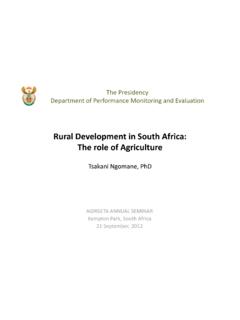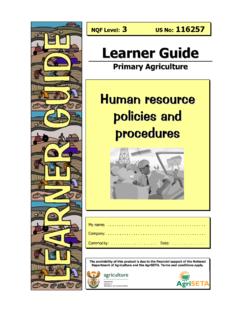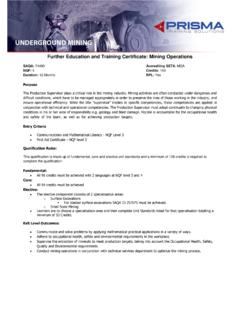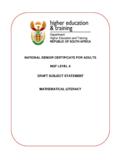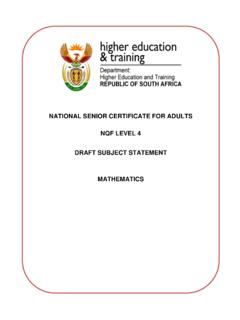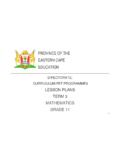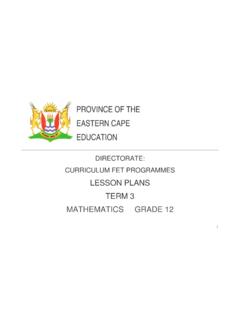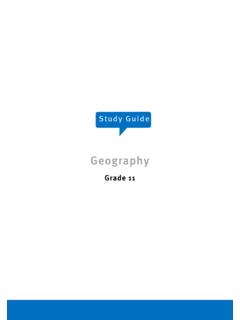Transcription of Shape aand motion - AgriSeta
1 AAsssseessssmmeenntt GGuuiiddee PPrriimmaarryy AAggrriiccuullttuurree SShhaappee aanndd mmoottiioonn NQF Level:3 US No: 9013 The availability of this product is due to the financial support of the National Department of Agriculture and the AgriSeta . Assessor: .. Workplace / Company: .. Commodity: .. Date: ..Describe, apply, analyse and calculate Shape and motion in 2-and 3-dimensional space in different contexts. Primary Agriculture NQF Level 3 Unit Standard No: 9013 22 Version: 01 Version Date: July 2006 BBeeffoorree wwee his assessment guide contains all necessary activities and instructions that will enable the assessor and learner to gather evidence of the learner s competence as required by the unit standard. This guide was designed to be used by a trained and accredited assessor whom is registered to assess this specific unit standard as per the requirements of the AgriSeta ETQA.
2 Prior to the delivery of the program the facilitator and assessor must familiarise themselves with content of this guide, as well as the content of the relevant Learner Workbook. The assessor, facilitator and learner must plan the assessment process together, in order to offer the learner the maximum support, and the opportunity to reflect competence. The policies and procedures that are required during the application of this assessment are available on the website of the AgriSeta and should be strictly adhered to. The assessor must familiarise him/herself with this document before proceeding. This guide provides step-by-step instructions for the assessment process of: This unit standard is one of the building blocks in the qualification listed below. Please mark the qualification you are currently assessing, because that will be determined by the context of application: Title ID Number NQF Level Credits Mark National Certificate in Animal Production 49048 3 120 U National Certificate in Plant Production 49052 3 120 U Please mark the learning program you are enrolled in: Are you enrolled in a: Y N Learnership?
3 U U Skills Program? U U Short Course? U U TT Title:Describe, apply, analyse and calculate Shape and motion in 2-and 3-dimensional space in different contexts. US No:9013 NQF Level: 3 Credits: 4 PPlleeaassee NNoottee:: This Unit Standard 9013 Assessment Guide must be read in conjunction with the generic Assessor Guide as prescribed and published by the AgriSeta . NNoottee ttoo AAsssseessssoorr:: If you are assessing this module as part of a full qualification or learnership, please ensure that you have familiarized yourself with the content of the qualification. Describe, apply, analyse and calculate Shape and motion in 2-and 3-dimensional space in different contexts. Primary Agriculture NQF Level 3 Unit Standard No: 9013 33 Version: 01 Version Date: July 2006 calculate the surface area of each of the following shapes: 1. Model Answer(s): 1. Area = Area 1 + Area 2 Area 1 is a semi-circle, half a circle Area = x x radius x radius + length x breadth = x x 7m x 7m + 14m x 8m = 76,97m2 + 112m2 = 188,97m2 2.
4 2. Area = Area 1 + Area 2 Area 1 is a semi-circle, half a circle Area = x x radius x radius + x base x height of triangle = x x 7m x 7m + x 9,8m x 10m = 76,97m2 + 49m2 = 125,97m2 3. calculate the shaded area 3. Shaded area = area of square area of circle = 20m x 20m x 10m x 10m = 400m2 314,16m2 = 85,84m2 Instructions to learner: Individual assignment 11 SSOO 11 Learner Guide: Page 10 Facilitator Guide: Page 12 MMyy NNootteess .. Describe, apply, analyse and calculate Shape and motion in 2-and 3-dimensional space in different contexts. Primary Agriculture NQF Level 3 Unit Standard No: 9013 44 Version: 01 Version Date: July 2006 1. A swimming pool is 7m long, 5m wide, and 3m deep. It has the same depth everywhere. What is the inside surface of the swimming pool and what is the volume (in m3)? Drawing of pool Net diagram 2. calculate the volume of a cylinder with a radius of 3 metre and a depth of 5 metre.
5 What is the surface area of the wall of the cylinder? 3. A farmer decided to build a dam on this farm. He wanted to have a cylindrical shaped dam. The diameter of the dam was to be 20m and the depth was to be 4m. How many cubic meters of water will the dam hold when it is full? Model Answer(s): 1. Drawing of pool Volume = area of base x height = 7m x 5m x 3m = 105m3 Instructions to learner: Individual assignment 22 SSOO 11 Learner Guide: Page 14 Facilitator Guide: Page 12 Describe, apply, analyse and calculate Shape and motion in 2-and 3-dimensional space in different contexts. Primary Agriculture NQF Level 3 Unit Standard No: 9013 55 Version: 01 Version Date: July 2006 Net diagram Total area = area 1 + 2 x area 2 + 2 x area 3 = 5mx7m + 2x3mx7m + 2x3mx5m = 35m2 + 42m2 + 30m2 = 107m2 2. Diagram Surface area of wall of cylinder = area 2 = area of rectangle We need to calculate the length of the top and bottom of the rectangle.
6 This is the same as the circumference of the circle. Circumference = 2x r = 2 x x 3 x 3m = 18,8m Area = length x breadth = 18,8m x 5m = 94m2 Volume = area of base x height = r2 x h = x 3m x 3m x 5m = 141,4m3 3. Diagram Volume = area of base x height = area of circle x height = x 10m x 10m x 4m = 1256,6m3 Describe, apply, analyse and calculate Shape and motion in 2-and 3-dimensional space in different contexts. Primary Agriculture NQF Level 3 Unit Standard No: 9013 66 Version: 01 Version Date: July 2006 a. You have to estimate the length and width and height of the classroom in centimetres as well as metres. Thereafter you have to use a measuring instrument such as a ruler or a measuring tape to obtain a more accurate answer. Write down the method you followed to obtain an estimate as well as the more accurate answer and your answer. b. Why is there a difference in your estimated values when compared to the values you obtained from the measuring instrument c.
7 calculate the floor area of your classroom in centimetres2. Area = d. calculate the floor area of your classroom in metres2. Area = e. calculate the volume of your classroom in cm3 Volume = f. calculate the volume of your classroom in m3 Volume = g. calculate the volume of your classroom in litres Volume = Instructions to learner: Individual assignment 33 SSOO 11 AAcctt 33 aa -- gg Learner Guide: Page 15 Facilitator Guide: Page 12 Describe, apply, analyse and calculate Shape and motion in 2-and 3-dimensional space in different contexts. Primary Agriculture NQF Level 3 Unit Standard No: 9013 77 Version: 01 Version Date: July 2006 Model Answer(s): a. Method followed Answer Estimate method There is no specific answer. The facilitator/assessor should however ensure that the learner s answers make logical sense.
8 The purpose of the question is to assist learners to learn how to estimate distances. Length_____cm Width _____ cm Height _____ cm Length _____ m Width _____ m Height _____ m Measuring instrument used Length_____cm Width _____ cm Height _____ cm Length _____ m Width _____ m Height _____ m b. Estimation is what it is estimation. It is never exactly the same answer compared to a calibrated measuring instrument. c. Area = The assessor will have to calculate the area of the specific classroom and compare learner answers to his own calculations d. Area = When comparing cm2 to m2, the answer in cm2 is always 10 000 times larger than m2. e. Volume = Will vary between different classrooms. Assessor will have to perform his own calculation f. Volume = When comparing cm3 to m3, the answer in cm3 is always 1 000 000 times larger than m3.
9 1 litre = 1000cm3. g. Volume = see above MMyy NNootteess .. Describe, apply, analyse and calculate Shape and motion in 2-and 3-dimensional space in different contexts. Primary Agriculture NQF Level 3 Unit Standard No: 9013 88 Version: 01 Version Date: July 2006 a. You have to determine the volume of a glue stick. You fill a measuring cylinder with 500 ml of water. Thereafter you add the glue stick into the water. The level of the water rises to 550 ml. What is the volume of the glue stick in ml and in cm3? b. What is the mass of the pineapple on the kitchen scale? c. What is the range that the kitchen scale can measure? d. A block is put on a triple-balance beam. What is the mass of this object? e. What is the range that this triple balance beam can measure? Model Answer(s): a. Volume of glue stick = 550 ml 500ml = 50 ml Volume = 50cm3 b. 500g or c. 0 kg to kg h. i. 0 to 610 g Instructions to learner: Individual assignment 44 SSOO 11 Learner Guide: Page 18 Facilitator Guide: Page 12 Describe, apply, analyse and calculate Shape and motion in 2-and 3-dimensional space in different contexts.
10 Primary Agriculture NQF Level 3 Unit Standard No: 9013 99 Version: 01 Version Date: July 2006 a. What is the time on your watch right now? How does this compare with the times of two other learners in class? b. How can you ensure that the time on your watch is accurate? c. Go outside of the classroom. Measure the time it takes two learners walking at different speeds to walk around the classroom. How does your answers compare to that of the other learners? Model Answer(s): a. Variable answer possible depending on the times the learners have on their watches. b. Set it according to the SABC time signal 07:00 or 13:00 during the day. Another method is to phone Telkom 1026. c. Variable answer possible depending on the timekeeping equipment used by learners and how accurate they started and stopped their timekeeping equipment. Instructions to learner: Individual assignment 55 SSOO 11 Learner Guide: Page 20 Facilitator Guide: Page 12 MMyy NNootteess.
